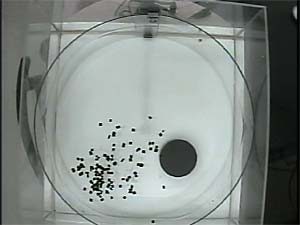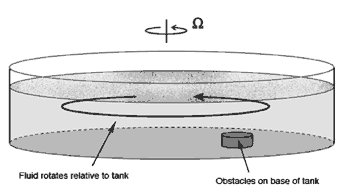Introduction | Tank – How to | Tank – Examples | Theory | Wiki
We place our 16” by 16” square tank on our turntable, place inside our cylindrical insert, and fill the tank up with water to mid-depth. An obstacle whose height is a small fraction of the fluid depth (a hockey puck is perfect) is placed on the base of the tank of water. The whole arrangement is then spun up on the turntable to a speed of 5 rpm (or so) and left until it comes into solid body rotation. Top and side views of the arrangement are shown in Fig.1 and Fig.2, respectively.
Fig.1. Top view shows the circular insert in the square tank, the puck on the base and paper dots floating on the surface, upstream of the puck.
Black paper dots are sprinkled liberally over the surface ‘upstream’ of the puck, as shown in Fig.1. We now make a very small (almost imperceptible) reduction in Ω (by 0.1 rpm or less). Until a new equilibrium is established (the “spin-down” process takes several minutes, depending on rotation rate and water depth), horizontal flow will be induced relative to the obstacle. The black paper dots reveal that the flow moves around, rather than over, the obstacle as if the obstacle extended through the whole depth of the fluid.
Fig.2. Side view of the Taylor-Proudman experiment
Note that this is a tricky experiment and requires some practice and care for it to be successful every time. It is important to leave the apparatus sufficiently long that it comes in to true solid body rotation. It is also important to turn down the rate of rotation of the tank by only a tiny amount, so as to keep the implied Ro as small as possible.

